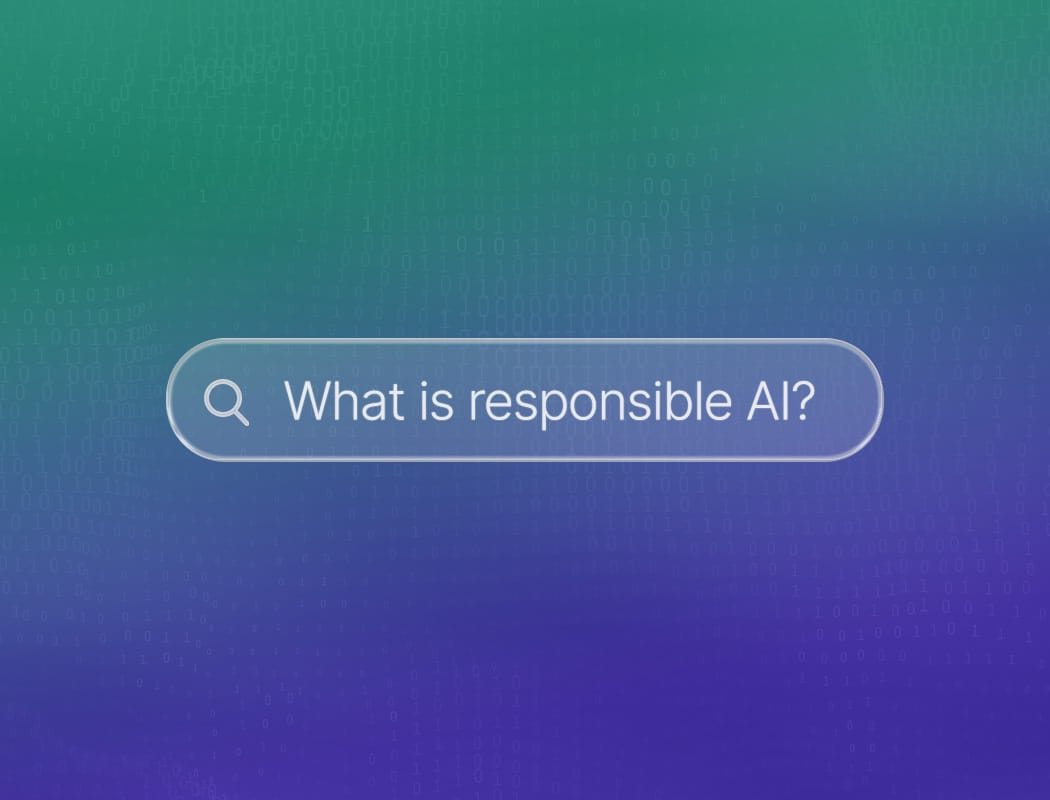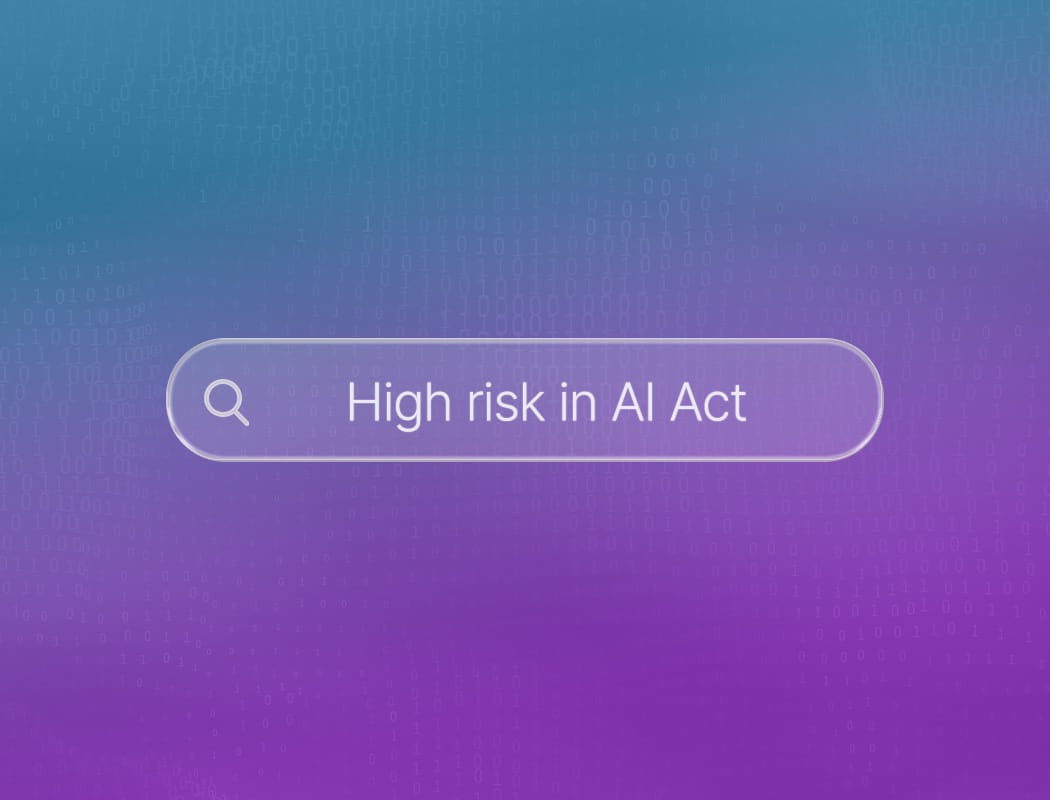What is responsible AI?
Responsible artificial intelligence is about building and using AI systems that are fair, safe, and trustworthy. It means thinking about the impact of technology on people and making sure AI decisions are transparent and explainable.
Responsible AI also involves protecting privacy, reducing bias, and ensuring that humans stay in control. Companies and developers need to ask tough questions before launching new tools. Who might be affected? What could go wrong? How can we fix mistakes quickly?
Responsible AI also means meeting key requirements such as protecting privacy, reducing bias, promoting inclusivity, and ensuring meaningful human oversight.
Systems should support human decision-making, and must remain accountable throughout their lifecycle. Developers need to be able to justify design choices, document performance, and allow independent review.
Concepts linked to responsible AI
Responsible AI is the practical side of Trustworthy AI, it turns principles into action. This approach is closely tied to the concept of Trustworthy AI, built on three pillars:
- Lawfulness: (complying with regulations like the GDPR and the EU AI Act)
- Ethical behavior (respecting human dignity, autonomy, and fairness)
- Robustness (ensuring technical reliability, safety-by-design, and resilience against misuse).
The EU’s risk-based AI Act reflects this thinking. Some uses, like social scoring, are banned outright. High-risk systems, such as those used in healthcare or recruitment, face strict safeguards like transparency obligations, human control, and rigorous testing.
New tools like regulatory sandboxes let innovators and regulators work together in controlled environments to check safety and compliance before large-scale deployment.

Why is responsible AI important?
Responsible AI matters because it shapes the way technology interacts with people and society. When artificial intelligence is built and used thoughtfully, it can help solve big problems, make life easier, and open up new opportunities for everyone.
But if we ignore responsibility, AI can cause harm, reinforce unfairness, or even put people at risk. That’s why it’s so important to think carefully about how we design, train, and use these powerful tools.
1. Fairness and bias
AI systems learn from data, and that data often reflects the world as it is, not as it should be. This means AI can sometimes give wrong answers or flawed decisions. In daily use, AI may also make smaller mistakes, and if the same mistake keeps happening in a consistent pattern, we call that bias.
For example, a hiring tool might favor certain groups over others, or a loan approval system could deny credit based on factors that shouldn’t matter. Responsible AI means checking for these biases and working to fix them before they cause harm.
It’s about making sure that everyone gets a fair shot, no matter who they are or where they come from. This takes effort, but it’s essential if we want AI to help rather than hurt.
2. Transparency and trust
People need to understand how AI makes decisions, especially when those decisions affect their lives. If an algorithm denies someone a job or a loan, they deserve to know why.
Responsible AI is about making these systems more transparent, so users and regulators can see what’s going on under the hood. This doesn’t mean everyone needs to become a programmer, but it does mean that companies should explain their AI in clear, simple terms.
When people trust that AI is being used responsibly, they’re more likely to accept and benefit from it. Trust is hard to earn and easy to lose, so transparency is key.
3. Accountability and safety
When something goes wrong with AI, who is responsible? That question is at the heart of responsible AI. Companies and developers need to take ownership of their systems, making sure they work as intended and don’t cause harm.
This means testing AI thoroughly, monitoring its performance, and being ready to step in if things go off track. It also means having clear rules about who is accountable when mistakes happen.
Safety is another big part of this. AI should be designed to avoid accidents, protect privacy, and keep people out of harm’s way. Accountability and safety go hand in hand, making sure AI serves people, not the other way around.
4. Long-term impact and ethics
Lastly, responsible AI asks us to think beyond short-term profits or quick fixes. It challenges us to consider the bigger picture:
How will this technology change jobs, communities, or even the planet? Are we building systems that respect human rights and dignity?
Using ethical AI, is about doing the right thing, even when it’s hard or inconvenient. By thinking long-term and acting ethically, we can guide AI toward outcomes that benefit everyone, not just a lucky few. That’s why responsible AI is so important.
How do industries use responsible AI?
From healthcare to finance, responsible AI is shaping how organizations make decisions, protect data, and serve people better. The goal is to use technology in ways that are fair, ethical, and accountable.
As more businesses rely on AI for daily operations, the need for responsible practices grows. This shift is not limited to one sector. Instead, it stretches across many fields, each with its own unique challenges and opportunities.
Healthcare industry
Healthcare is one of the industries that is leading the way in adopting responsible artificial intelligence. Hospitals and clinics use AI to diagnose diseases, manage patient records, and even predict outbreaks.
These tools can save lives by catching illnesses earlier and improving treatment plans. But they must ensure that these systems are accurate, unbiased, and explainable to protect patient safety and trust.
A wrong diagnosis or hidden error in the algorithm can have serious consequences, so continuous monitoring and human oversight are essential.
Finance industry
In finance, AI helps banks detect fraud, assess credit risk, and automate customer service. These systems work behind the scenes to spot suspicious transactions in seconds, prevent identity theft, and make lending decisions faster.
Also, in this industry are transparency and fairness crucial, as mistakes can directly affect people’s lives and livelihoods. Customers need to know why a loan was denied or a payment flagged and their financial data must be protected by all means.
Retailing
Retailers use artificial intelligence to personalize shopping experiences and manage inventory. AI-driven recommendations help customers find what they need, while smart supply chains keep products available and reduce waste. These systems can make shopping faster, easier, and more enjoyable.
However, retailers must be careful to avoid bias in recommendations and respect customer privacy at every step. Clear communication about how data is used can build trust and turn one-time shoppers into loyal customers.
How does responsible AI impact decision-making?
When AI is developed and used responsibly, it helps leaders make choices that are not only smarter but also fairer. This shift is reshaping everything from hiring practices to customer service, and even the way products are designed.
Building trust through transparency
One of the biggest impacts of responsible artificial intelligence on decision-making is the boost in transparency. In the past, decisions powered by algorithms often felt like black boxes. No one really knew how or why a certain outcome was reached.
With responsible AI, the process becomes much clearer. Teams can trace back each recommendation or prediction to the data and logic that produced it. This means stakeholders can ask questions, challenge assumptions, and understand the reasoning behind every choice.
Transparency builds trust, both inside and outside the organization. Customers feel more comfortable when they know how their data is being used, and employees are more likely to embrace new tools when they can see how decisions are made.
Reducing bias and promoting fairness
Bias has always been a risk in decision-making, whether human or machine. Responsible artificial intelligence tackles this head-on by putting safeguards in place to identify and reduce bias.
This might mean using diverse data sets, regularly testing for unfair outcomes, or involving a wide range of voices in the design process. The result is a system that treats everyone more fairly.
For example, in lending, it can help banks avoid patterns that have historically excluded certain groups. By promoting fairness, responsible AI helps organizations build stronger relationships with customers and communities.
Enabling faster and more accurate decisions
Speed and accuracy are two things every business wants in its decision-making. Responsible artificial intelligence delivers both. By analyzing huge amounts of data quickly, AI can spot trends and patterns that humans might miss.
This leads to faster responses and more informed choices. But responsible AI goes a step further. It’s not just about making decisions quickly—it’s about making the right decisions.
With built-in checks and balances, responsible AI systems flag uncertainties or gaps in the data, so leaders can pause and dig deeper when needed. This balance between speed and caution helps organizations stay agile without sacrificing quality.





